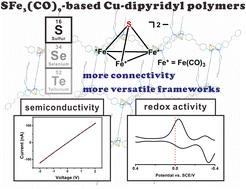当前位置:
X-MOL 学术
›
Dalton Trans.
›
论文详情
Our official English website, www.x-mol.net, welcomes your feedback! (Note: you will need to create a separate account there.)
Inorganic–organic hybrid Cu–dipyridyl semiconducting polymers based on the redox-active cluster [SFe3(CO)9]2−: filling the gap in iron carbonyl chalcogenide polymers
Dalton Transactions ( IF 4 ) Pub Date : 2024-03-26 , DOI: 10.1039/d4dt00254g Ming-Chi Hsu , Ru Yan Lin , Tzu-Yen Sun , Yu-Xin Huang , Min-Sian Li , Yu-Huei Li , Hui-Lung Chen , Minghuey Shieh
Dalton Transactions ( IF 4 ) Pub Date : 2024-03-26 , DOI: 10.1039/d4dt00254g Ming-Chi Hsu , Ru Yan Lin , Tzu-Yen Sun , Yu-Xin Huang , Min-Sian Li , Yu-Huei Li , Hui-Lung Chen , Minghuey Shieh

|
The construction of sulfur-incorporated cluster-based coordination polymers was limited and underexplored due to the lack of efficient synthetic routes. Herein, we report facile mechanochemical ways toward a new series of SFe3(CO)9-based dipyridyl–Cu polymers by three-component reactions of [Et4N]2[SFe3(CO)9] ([Et4N]2[1]) and [Cu(MeCN)4][BF4] with conjugated or conjugation-interrupted dipyridyl ligands, 1,2-bis(4-pyridyl)ethylene (bpee), 1,2-bis(4-pyridyl)ethane (bpea), 4,4′-dipyridyl (dpy), or 1,3-bis(4-pyridyl)propane (bpp), respectively. X-ray analysis showed that bpee-containing 2D polymers demonstrated unique SFe3(CO)9 cluster-armed and cluster-one-armed coordination modes via the hypervalent μ5-S atom. These S–Fe–Cu polymers could undergo flexible structural transformations with the change of cluster bonding modes by grinding with stoichiometric amounts of dipyridyls or 1/[Cu(MeCN)4]+. They exhibited semiconducting behaviors with low energy gaps of 1.55–1.79 eV and good electrical conductivities of 3.26 × 10−8–1.48 × 10−6 S cm−1, tuned by the SFe3(CO)9 cluster bonding modes accompanied by secondary interactions in the solid state. The electron transport efficiency of these polymers was further elucidated by solid-state packing, X-ray photoelectron spectroscopy (XPS), X-ray absorption near-edge spectroscopy (XANES), density of states (DOS), and crystal orbital Hamilton population (COHP) analysis. Finally, the solid-state electrochemistry of these polymers demonstrated redox-active behaviors with cathodically-shifted patterns compared to that of [Et4N]2[1], showing that their efficient electron communication was effectively enhanced by introducing 1 and dipyridyls as hybrid ligands into Cu+-containing networks.
中文翻译:

基于氧化还原活性簇[SFe3(CO)9]2−的无机-有机杂化铜-联吡啶半导体聚合物:填补铁羰基硫属化物聚合物的空白
由于缺乏有效的合成路线,掺硫簇基配位聚合物的构建受到限制且尚未得到充分探索。在此,我们报道了通过[ Et 4 N ] 2 [SFe 3 ( CO ) 9 ] ([Et 4 N] 2 [ 1 ]) 和 [Cu(MeCN) 4 ][BF 4 ] 与共轭或共轭中断的联吡啶配体、1,2-双(4-吡啶基)乙烯 (bpee)、1,2-双(4-吡啶基) ) 乙烷 (bpea)、4,4'-联吡啶 (dpy) 或 1,3-双(4-吡啶基)丙烷 (bpp)。 X射线分析表明,含bpee的2D聚合物通过高价μ 5 -S原子表现出独特的SFe 3 (CO) 9簇臂和簇单臂配位模式。通过用化学计量的联吡啶或1 /[Cu(MeCN) 4 ] +研磨,这些 S-Fe-Cu 聚合物可以随着簇键合模式的变化而经历灵活的结构转变。它们表现出具有1.55–1.79 eV的低能隙和3.26 × 10 -8 –1.48 × 10 -6 S cm -1的良好电导率的半导体行为,通过伴随二次相互作用的SFe 3 (CO) 9团簇键合模式进行调节在固态。这些聚合物的电子传输效率通过固态堆积、X射线光电子能谱(XPS)、X射线吸收近边光谱(XANES)、态密度(DOS)和晶体轨道汉密尔顿布居进一步阐明。 COHP)分析。最后,与[Et 4 N] 2 [ 1 ]相比,这些聚合物的固态电化学表现出具有阴极转移模式的氧化还原活性行为,表明通过引入1和联吡啶作为杂化物,它们的有效电子通讯得到了有效增强配体进入含Cu +网络。
更新日期:2024-03-26
中文翻译:

基于氧化还原活性簇[SFe3(CO)9]2−的无机-有机杂化铜-联吡啶半导体聚合物:填补铁羰基硫属化物聚合物的空白
由于缺乏有效的合成路线,掺硫簇基配位聚合物的构建受到限制且尚未得到充分探索。在此,我们报道了通过[ Et 4 N ] 2 [SFe 3 ( CO ) 9 ] ([Et 4 N] 2 [ 1 ]) 和 [Cu(MeCN) 4 ][BF 4 ] 与共轭或共轭中断的联吡啶配体、1,2-双(4-吡啶基)乙烯 (bpee)、1,2-双(4-吡啶基) ) 乙烷 (bpea)、4,4'-联吡啶 (dpy) 或 1,3-双(4-吡啶基)丙烷 (bpp)。 X射线分析表明,含bpee的2D聚合物通过高价μ 5 -S原子表现出独特的SFe 3 (CO) 9簇臂和簇单臂配位模式。通过用化学计量的联吡啶或1 /[Cu(MeCN) 4 ] +研磨,这些 S-Fe-Cu 聚合物可以随着簇键合模式的变化而经历灵活的结构转变。它们表现出具有1.55–1.79 eV的低能隙和3.26 × 10 -8 –1.48 × 10 -6 S cm -1的良好电导率的半导体行为,通过伴随二次相互作用的SFe 3 (CO) 9团簇键合模式进行调节在固态。这些聚合物的电子传输效率通过固态堆积、X射线光电子能谱(XPS)、X射线吸收近边光谱(XANES)、态密度(DOS)和晶体轨道汉密尔顿布居进一步阐明。 COHP)分析。最后,与[Et 4 N] 2 [ 1 ]相比,这些聚合物的固态电化学表现出具有阴极转移模式的氧化还原活性行为,表明通过引入1和联吡啶作为杂化物,它们的有效电子通讯得到了有效增强配体进入含Cu +网络。



























 京公网安备 11010802027423号
京公网安备 11010802027423号